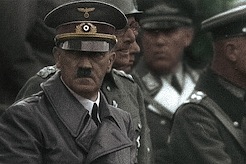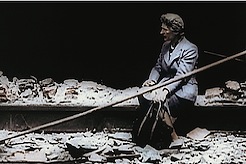Apocalypse -- not now but then
11/10/09 05:19 PM


By ED BARK
World War II isn't exactly under-exposed. So it's hard to know how much of Smithsonian Channel's six-hour Apocalypse lives up to claims that most of its footage is hardly same-old, same-old.
"The footage deemed 'unfit' for civilians to see. Until now," publicity materials crow. " 'Top Secret' footage rediscovered, declassified and restored in full-color high definition."
The "full-color" in fact is pretty washed out, at least in the two episodes sent for review. And that's probably for the better, given some of the stark images presented.
Narrated by Martin Sheen, Apocalypse fittingly begins on Veteran's Day (Wednesday, Nov. 11th) and continues for five successive nights at 7 p.m. central.
"The series will forever change the way we look at the Second World War," Smithsonian Channel says. "This was not the stock newsreel or propaganda footage that the world had become all too familiar with seeing. This was provocative footage filmed by those who witnessed the war first-hand."
Hour 1, subtitled "Aggression," begins in Berlin, 1945 before quickly tracing Adolf Hitler's rise to power. Hour 3 ("Shock"), also sent for review, is starker and more powerful in its footage of the Nazi Army's march toward Moscow in conditions ranging from dusty/bumpy to impossibly muddy to brutally cold. This footage, taken by soldiers using 8mm cameras, is legitimately jaw-dropping at times. As is the brutality of the German Army toward Soviet Jews and others.
The script read by Sheen can be a bit pedestrian at times. But the pictures often are anything but. In Wednesday's opener, we see both children and horses being outfitted with gas masks. And Hour 3 brings the truly incredible sight of white-clad Siberians attacking the Nazis on their skis.
Hitler is caught in closeup throughout, as are Nazi higher-ups who seem to look even more evil. The devastation and delusion are ever-present, with body counts in the hundreds and hundreds of thousands.
Apocalypse is starkly powerful in its linear depiction of World War II's horrors and jarring forms of humanity. Early in Hour 3, Nazis aboard their U-boats can be seen tossing scraps of bread to enemy soldiers on life rafts after they abandoned their sunken ships.
Almost all were doomed to die from starvation or the elements, narrator Sheen notes. And the Germans weren't about to save them.
GRADE: B+
